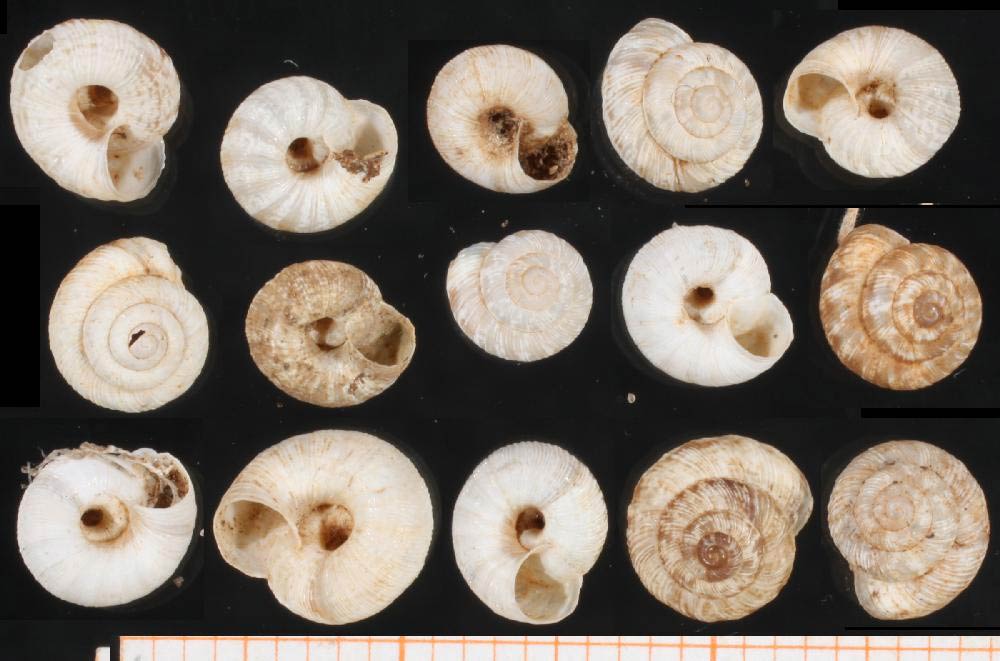Microxeromagna lowei
Family
Hygromiidae
Species
Microxeromagna lowei (Potiez and Michaud, 1852)
Common name
Small brown snail, Citrus snail
Description
The shellShell:
A hard, inflexible, calcareous or chitinous structure that vary in size and may either completely encasing the animal, covering some part of it or be internal.
of this species is 3-5 mm high and 5.5-8.5 mm wide, with 4.5 whorlsWhorls:
Pleural of whorl. A whorl is a complete spiral turn/growth of the shell of a mollusc. The whorls are counted from the apex outwards.
. The shellShell:
A hard, inflexible, calcareous or chitinous structure that vary in size and may either completely encasing the animal, covering some part of it or be internal.
is tan with numerous brown spots of various shades. The lower portion of the shellShell:
A hard, inflexible, calcareous or chitinous structure that vary in size and may either completely encasing the animal, covering some part of it or be internal.
has narrow stripes that are not continuous. There may be short hairs covering the shells (0.05 mm long). In many empty shells, the hair may be absent due to abrasion of the surface, leaving hair scars. It has a narrow umbilicusUmbilicus:
A navel-like indentation or depression in the center of the shell. It may be described as open (inside of columella visible), partially closed (partly covered by base of aperture) or completely closed (not visible). The width of the umbilicus is a measure of its greatest diameter.
. The body of the animal is white with a brown spot at the margin of the mantleMantle:
A fleshy, membranous covering of the anterior portion of the body of a mollusc. It secretes the materials that form the shell.
.
Native range
Western Mediterranean region
Distribution
Australasia: Australia
Africa: Canary Islands to Israel and Lebanon
Europe: Italy; Spain; Mediterranean
Ecology
The small brown snail occupies terrestrial and arborealArboreal:
Of or relating to trees OR Tree-dwelling or frequenting trees.
habitats. It is generally a contaminant of citrus exports from Australia. Shipments to the U.S. have been rejected due to contamination by this species. Both adults and juveniles of this species may be found in citrus trees on the leaves and fruit as well as in the leaf litter below the trees. This complicates management strategies for this species. The small brown snail is also a pest of cereals as they generally aggregate on the leaves and seed headHead:
The area of a mollusc's body that has the tentacles, eyes and mouth.
. They contaminate cereal grains and increase the moisture content. This allows for the introduction of secondary fungal pathogens which may produce toxins. The toxins produced by these secondary fungal pathogens may cause fatality and reproductive disorders in humans and cattle. The snail density may attain 4000 snails/m2. This self-fertile species can mature within 6 weeks and will lay on average 500 eggs per year in the soil.
Synonyms
- Microxeromagna arrouxi
- Microxeromagna vestita
- Microxeromagna armillata (Lowe)
- Helix lowei Potiez & Michaud, 1838
- Helix (Xerophila) armillata Lowe, 1852
- Helix vestita Rambur, 1868
- Helix subsecta Tate, 1879
- Helicella (Candidula) mayeri Gude, 1914
References
Zhao et al. 2004Zhao et al. 2004:
Zhao, Z.Q., I.T. Riley and A.L. Lush. 2004. Effect of temperature and antibiotics on the hatching of Microxeromagna armillata (Mollusca: Hygromiidae) eggs: developing an in vitro bioassay for fungal egg parasites. Molluscan Research 24: 1-5.


